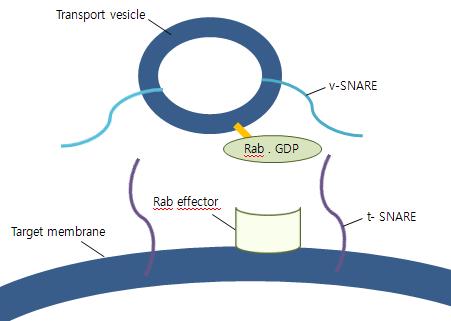What is the Difference Between v-SNARE and t-SNARE
Table of Contents
The key difference between v-SNARE and t-SNARE is that v-SNARE is associated with the membrane of transport vesicle during the process of budding while t-SNARE is associated with nerve terminal membranes.
SNARE (an acronym derived from soluble N-ethylmaleimide sensitive fusion protein (NSF) attachment receptor) is a large protein family that consists of 24 different types of Saccharomyces cerevisiae and 60 different types of mammalian cells. The main function of SNARE proteins is to mediate the fusion of the vesicle with target membranes. In other words, SNARE proteins mediate exocytosis. They also mediate the fusion of membrane-bound compartments such as lysosomes. SNAREs can be divided into two main categories: v (vesicle) – SNARE and t (target) – SNARE.
CONTENTS
1. Overview and Key Difference
2. What is v-SNARE
3. What is t-SNARE
4. Similarities – v-SNARE and t-SNARE
5. v-SNARE vs t-SNARE in Tabular Form
6. Summary – v-SNARE vs t-SNARE
What is v-SNARE?
v-SNARE is a type of SNARE protein associated with the membrane of transport vesicle during the process of budding, which mediates exocytosis. VAMP7 and VAMP 8 are two main examples of v-SNARE proteins. They contain more than 70% of branched amino acids within the transmembrane domain region.

Figure 01: SNARE Vesicles
V-SNARE aids exocytosis of large zymogen granules and mast cell vesicles, facilitating rapid pore expansion and release of bulky molecules such as interferon. R-SNAREs are members similar to v-SNARE, which mediate vesicle fusion similar to v-SNARE.
What is t-SNARE?
t-SNARE is a type of SNARE protein associated with nerve terminal membranes and form stable subcomplexes and functions as a guide for v-SNARE. Syntaxin 1 and SNAP-25 are members of larger protein families such as t-SNARE.

Figure 02: Types of SNAREs
Their specific localization to subcellular membranes defines where transport vesicles bind and fuse. Q-SNARE are members similar to t-SNARE that mediate vesicle fusion similar to t-SNARE.
What are the Similarities Between v-SNARE and t-SNARE?
- v-SNARE and t-SNARE are subtypes of SNARE proteins.
- They help to mediate the fusion of the vesicle with target membranes.
- Both play a major role in the process of exocytosis.
What is the Difference Between v-SNARE and t-SNARE?
The key difference between v-SNARE and t-SNARE is that v-SNARE is usually incorporated into the membrane of the transport vesicle during the process of budding, while t-SNARE is associated with nerve terminal membranes. Other terms for v-SNARE and t-SNARE are vesicle SNARE and target-SNARE, respectively. Another difference between v-SNARE and t-SNARE is their function. The function of v-SNARE is to mediate the process of exocytosis, while the function of t-SNARE is to form stable subcomplexes and function as a guide for v-SNARE. Moreover, VAMP7 and VAMP 8 are two main types of v-SNARE while Syntaxin 1 and SNAP-25 are two main types of t-SNARE.
The below infographic presents the differences between v-SNARE and t-SNARE in tabular form for side by side comparison.
Summary – v-SNARE vs t-SNARE
SNARE is a large protein family. v-SNARE is a type of SNARE protein associated with the membrane of transport vesicle during the process of budding, which mediates exocytosis. t-SNARE is a type of SNARE protein associated with the nerve terminal membranes. Moreover, the main function of SNARE proteins is to mediate the fusion of the vesicle with target membranes. In other words, SNARE proteins mediate exocytosis. t-SNAREs, on the other hand, form stable subcomplexes and function as a guide for v-SNARE. So, this summarizes the difference between v-SNARE and t-SNARE.
Reference:
1. Han, Jing, et al. “The Multifaceted Role of SNARE Proteins in Membrane Fusion.” Frontiers in Physiology, Frontiers Media S.A., 20 Jan. 2017.
2. “Snare (Protein).” SNARE (Protein) – an Overview | ScienceDirect Topics.
Image Courtesy:
1. “Vesicle docking1” By Kimgh5698 – Own work (CC BY-SA 3.0) via Commons Wikimedia
2. “Classificació SNAREs wiki” By BQUB17-ABriones – Own work (CC BY-SA 4.0) via Commons Wikimedia
ncG1vNJzZmivp6x7pbXFn5yrnZ6YsqOx07CcnqZemLyue9ahmK1lmah6tbTEZpuinpaav6a6wp5km52krLKmuoyvZKymkaeybq3NnWStZaOjrrOxjg%3D%3D